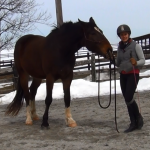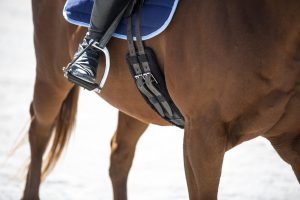Two weekends ago, I attended the Pennsylvania Horse Expo, which lucky for me, is only about an hour from my home, and offers a ton of free demonstrations and seminars from trainers all over the world. There was one trainer who I went to see early Sunday morning whose work really resonated with me. His name was Angelo Telatin, and in his demonstration he talked a lot about timing. The information was gold, so I wanted to share it with you, as well as some of my own thoughts on this subject.
There is no way around it, timing is critical with our horses. In fact the timing of our responses to our horse’s behavior is one of the most influential ways that we can communicate with them. Many horse people talk about “timing and feel,” but what exactly does this mean? Well, timing is applicable and can be discussed in several different situations. First, let’s look at simple pressure and release. If you are applying a form of pressure to your horse, for the purpose of motivating him to do something, let’s say its tapping him with a stick to get him to walk forward, and he begins to kick out. If you stopped tapping for whatever reason, (maybe his kick startled you, or you just didn’t want to make him angry) you have just taught your horse that kicking is the correct response to being tapped with a stick and will be effective in stopping the pressure. A few more repetitions and he’ll have that kick down pat. Rather, if you continue tapping through the kick, not whacking him as punishment for a wrong answer, but not releasing the pressure until he takes a step forward then stopping the tapping immediately – this correct timing of your release will help him understand exactly what you want (when I tap, you walk forward).
Now, let’s look at a reward example. Many of us like to feed our horses treats, but you need to have criteria for how your horse behaves when he receives a treat. If he comes over and nuzzles your jacket, nips at your hands, and is generally in your face about the food, then he is learning that nosing you, nipping, and investigating pockets equals a food reward. But if are aware of the timing of when you feed that treat, and you only ever feed a treat when your horse is standing quietly with his head away from you, the food pushy behavior will not develop. He may give it a try but will also give it up if you create some boundaries and never provide that food reward during nosy behavior.
Going back to pressure, timing is also important for knowing when to increase pressure. If a horse is trying, if he is searching for what you want, then you don’t want to increase the pressure or he will only become frustrated. On the other hand, pressure is used to motivate, so going back to the previous pressure and release example, if you are tapping your horse to ask for forward movement and he is falling asleep in the sun, you need to increase that pressure just until he wakes up and realizes something is being asked of him.
Considering these examples, it becomes easy to see how we can accidentally train our horses to do the exact opposite of what we want, and all by being too slow, too fast, or inappropriate in our release or rewards. Fortunately, just being aware of this concept can help us improve, so when you make a mistake, acknowledge that your timing was off and make it better the next time!
Finally, enjoy this week’s video on this subject, and leave a comment with other bad habits you can think of that can be a result of bad timing on our part!














13 Responses
Excellent post Callie! Such an important topic that is really important to be aware of. Thanks for continuing to share your insight!
Hi Callie, I can not help but wonder how horses know what tondo when students give them all kinds of incorrect cues. You are constantly talking about how to train horses and how important it is to train correctly . So if you train a horse beautifully and then expose him or her to all of these novice riders like myself who misapply the cues won’t the horse get completely confused and frustrated and so too the student ?
Hi Dianne, You make a great point! It is tough for lesson horses, and that is why many lesson horses get sour or just become more dull, less responsive to the rider’s cues. But making mistakes is all part of learning, and it is easier for new riders to learn on a trained horse, because when they do it right, and “find the button,” the horse will respond. Thankfully, a good lesson horse is very forgiving, and if the instructor takes steps to protect the lesson horses from painful mistakes and keep them fresh by incorporating some fun and reward for the horses into the lessons, they can be wonderful teachers!
Personally, I also feel that this is my role as a riding instructor – to set up the lessons in a way that the rider understands what I tell them, so that they can successfully guide the horse and learn without too much frustration for either horse or rider.
Great discussion, Callie! Thank you.
Great Video! I think so many of us are guilty of ‘bad timing’ especially when we are learning something new or see a behavior we arent sure of. As always you put it so simply that the concept is easy to understand. It definitely makes me more aware of my behavior! I struggle with the mounting block but I realize that I created his behavior from the beginning. First I need to train myself. lol Thank you!!!
Hi Callie, thank you for sharing with us this important information. It is very true timing… is very important with horses.!!
By the way, we put in practice what you teach us to correct Brunette’s problem of going backwards instead of forward. Wow, we are very happy because it worked! Know she get out of the pastures very nice and easy. She did it to me but I need to learn to tap her with out fear of her reaction. I’m working with my fears… The last time I ride her she got scared of a very big machine (that I don’t know the name in English, sorry…) she tried to go backwards and I didn’t had a crop with me so I stop her, talked to her softly, greet her when she calm down, then the man in the machine help me a little moving the machine a little bit, so we continue our way. But what I can do to help her with that fear?
Hi Wilma,
Glad Brunette is doing better! It sounds like you handled the machine situation very well! The best thing for horses to overcome their fears of different things like that is just exposure. Meaning the more often she sees that machine, the less she should be afraid of it. When a horse spooks at something you never want to punish them and you also don’t want to give the “scary thing” too much attention. If they want to be curious I will let them, otherwise I do my best to ignore the “monster” so the horse does not feel nervous energy from me as the rider.
Hi Callie!
So…. I did it the right way YES!! thank you for answering me, I will practice that with a machine that is stuck in the farm. When I was in the situation, at first I got a little nervous, surprisingly I did’t freak out and came to my mind the importance of being calm for me and for her safety. But I was insecure if what I did was right, because the way I saw other riders in the neighborhood spanking their horses to show who is the “boss”. You are helping me and a young girl who wants the results we are having with Brunette, even though she is a rider since 4 years old ( know she is 13 and she has her mare all that time) her mare use to run away from her, I’m sharing what I have learned with your videos and she is improving in her relationship with her beloved horse!!
Please don’t stop your commendable work !!!
Another wonderful video! When riding, what is the best response to a horse who threatens to buck or rear when asked to go where they don’t want to go? At this point I’m not secure enough to call the bluff from the saddle so I dismount and “move his feet,” then lead him past his chosen no-go zone. Anything I should do differently? Thank you so much!!
Hi Nancy, Your current approach is the one I would recommend. Do make sure he gets lots of praise as soon as the feet start moving forward too! When you feel comfortable enough in the saddle you can do essentially the same thing by putting him in a tight circle with one rein to prevent the bucking or rearing, then giving him the option to move forward again. If he refuses, another few circles, if he goes, lots of praise!
Hi Callie,
I am finding your video’s and information so helpful so glad I found you. I have a young horse, he has been backed by a trainer. I have been having lessons on him, but he is very scared of new things which makes me nervous and he has just started to rear when I lead him when he doesn’t want to go, I havn’t ridden him for a few weeks because our fields are too wet due to the weather. I shall keep watching your video’s to help me. Thanks Debbie.
Hi Debbie,
Thanks for your comment and best of luck with your young horse! Keep us updated with how he comes along.
Hi Callie, I am loving your tips and riding advice all the way over the pond in England. Loving the change of seasons we can see in your videos too 🙂 I so want to come and stay with you to learn more, you should offer board and training, I’d be the first to sign up! X